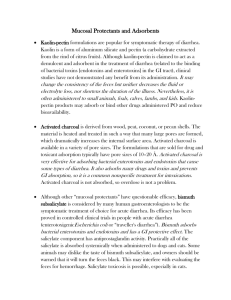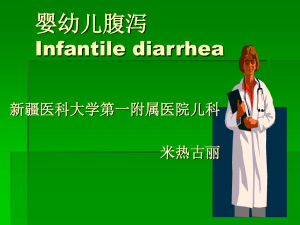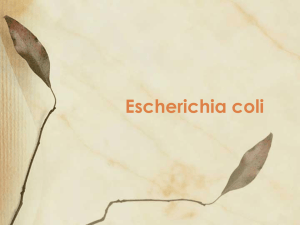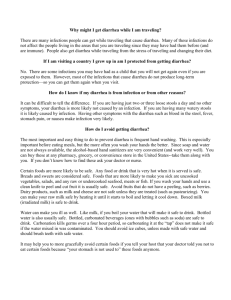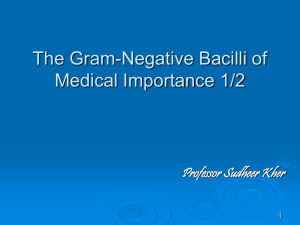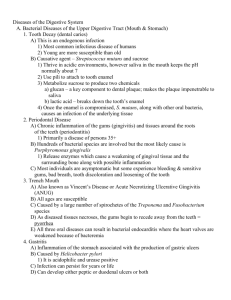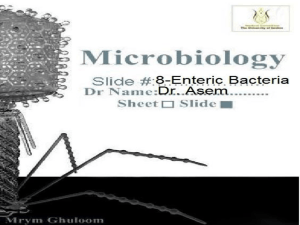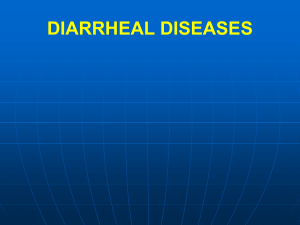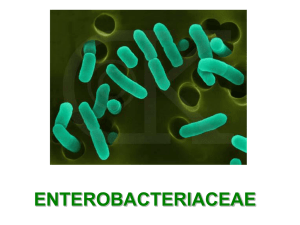Bacterial Gastrointestinal Infection
advertisement
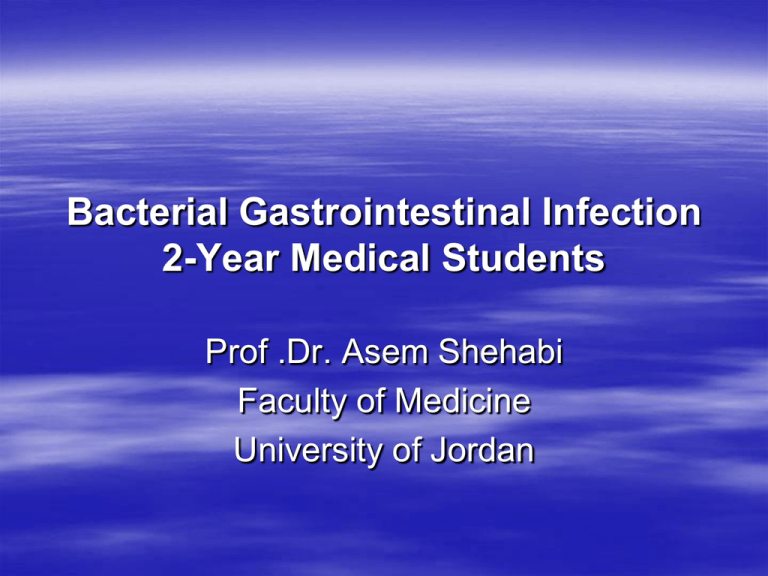
Bacterial Gastrointestinal Infection 2-Year Medical Students Prof .Dr. Asem Shehabi Faculty of Medicine University of Jordan Diarrheagenic E. coli-1 There are 6 groups of E. coli strains which have virulence factors causing human diarrhea..Widely distributed in water, animals & Birds..4 most important 1-Enterotoxigenic E. coli (ETEC). Common in domestic animals, Poultry, Humans ..Produces Heat stable /Heat –labile enterotoxins (plasmid borne) or both (LT+ ST).. fimbrial adhesins attached to enterocytes of the proximal small intestine epithelium.. LT Subunit B.. attached to GM1 Ganglioside.. release Subunit A.. Activate adenylyl cyclase .. increase cellular cAMP release .. Heat-stable toxin (ST) activates cGMP.. Both cause prolonged hyper secretion of water .. Sodium + chloride.. Inhibit reabsorption of sodium.. Mild/severe watery diarrhea, vomiting, abdominal pain.. No fever. E. coli Mucosal Attachment .. Adhesions Fimbriae-Pili.. CFA I & CFA II Diarrheagenic E. coli-2 ETEC strains are an important cause of diarrhea in infants – very young children in developing countries Common cause of Traveler’s diarrhea in developed countries.. Contaminated water .. Dairy products.. fresh vegetable food. Self- limited with Rehydration.. Antibiotics are rarely needed. 2- Entero-haemorrhagic E. coli (EHEC) or Verotoxigenic E. coli (VTEC).. mostly serotype O157: H7.. Produces Shiga-like toxin.. common in intestines of animals.. cows.. contamination milk & ground beef meat.. causes outbreaks of gastroenteritis ..4000 cases, 600 HUS, 55 deaths.. 2012,Germany Diarrheagenic E. coli-3 Complications.. severe inflammation & ulceration colon.. bleeding.. Haemorrhagic colitis.. If toxin reached blood.. Haemolytic Uraemic Syndrome (HUS).. More severe in children.. Blood+ Protein in urine.. Kidney failure ..fatal Prevention is better than treatment with antimicrobials. 3-Entero-pathogenic E.coli (EPEC).. adherence to GI epithelium.. distortion.. Numerous serotypes.. K, LPS Antigens .. Common infection in neonates.. Outbreaks in babies nurseries aged less 6 months.. watery diarrhea & vomiting.. Chronic diarrhea. 4-Entero-invasive E.coli (EIEC).. like Shigella.. cause bloody diarrhoea.. Vomiting.. Abdominal pain.. Fever.. by invasion of damaging intestinal epithelial cells.. necrosis.. Affect all ages..more pathogenic in children. Lab Diagnosis Detection of Diarrheagenic E. coli strains in the laboratory is difficult.. complicated by the fact that nonvirulent E. coli strains are normally present in the feces.. Lactose+ve Stool culture.. MacConkey agar.. Identification by PCR more accurate than biochemical and serotyping.. Antibiotic treatment is recommended in severe & chronic cases.. Ciprofloxacin, Co-trimoxazole is recommended for drug-sensitive strains.... parenteral second-generation or third-generation cephalosporin for systemic complications. No vaccines are available Campylobacter Campylobacter spp. are Microaerophlic.. Gram-negative ..Spiral shape.. Bipolar flagella.. Motile.. Isolation on selective special medium at 42 C. Commonly present in the GIT of domestic animals.. poultry & pets .. Contaminate easily Meat.. Dairy products.. Food contamination & direct contact with animals.. Common cause of diarrhea in Western countries..Less in Arab countries. Campylobacter jejuni.. common cause acute enteritis.. Bloody diarrhea.. Infants, children > adults, Elderly, Immunecompromised.. Rare septicemia.. Reactive arthritis.. Infection mostly self-limited without treatment.. few days.. Pathogenesis.. Endotoxin & various enterotoxin, cytotoxins..Prolong carriage associated with imunodeficincey. C. fetus.. Less common in human.. Causes sepsis & abortion in animals. Serological test is not significant in diagnosis clinical cases. Treatment: Macrolides/Azithromycin, Ciprofloxacin, Ampicillin Campylobacter- Vibrio cholera Helicobacter pylori H. pylori infection is expected to be present in stomach of 30%-90% of world’s population ..causes no signs or symptoms and doesn't lead to any complications in the majority of persons.. H. pylori infection discovered 1983 as cause of chronic gastritis.. Serious complications.. Peptic /dudenal ulcers.. Lymphoma, stomach cancer in 2% of colonized persons worldwide over a long period H. pylori ..Microaerophlic to Anaerobes.. Gram-ve bacteria, spiral shape, motile, polar 4-6 flagella .. produces potent urease, support its survive in gastric mucous layer near the epithelial surface.. neutralize stomach acidity. Protease & outermembrane antigens (Cytotoxins) Causing chronic inflammation of the inner lining of the stomach mucosa Helicobacter infection Diagnosis & Treatment Infection is most likely acquired by ingesting contaminated food, water , personal contact Causes Re-infection is common..No vaccine Optimal growth..Special culture medium, 90%, Co2 37C. Urease breath test by drink a harmless liquid and in less than 1 hour, a sample of breath is tested.. Rapid urease test for identification H. pylori in gastric biopsy taken by endoscope or culture Giemsa /silver stain.. histological biopsy specimens. Treatment: Metronidazole + Clarithromycin or Bismuth sulfate + Metronidazole + Amoxicillin + H2 Blockers.. Vibrios-1 Vibrios are Gram-negative straight or curved rods, oxidase-positive, motile.. single polar flagellum ..widely distribute in sea water ..2-3% NaCl.. Classical V. cholerae (serotypes 01, 0139).. Cause Epidemic- Pandemic Cholera.. Noninvasive.. Affecting small intestine through secretion of an EnterotoxinHeat-labile /Cholera Toxin.. Increasing cAMP.. Incub. 8-24h..Severe watery diarrhea, dehydration, shock, acidosis, death within 24 h.. Cause Only Human Infection. Partial immunity developed following infection.. Specific developed antitoxin antibodies in intestine last for 1-year ..Oral Vaccine used in endemic areas.. prevent re-infection up to 50% Vibrios-2 Non-01 V. cholerae.. Less virulent.. watery diarrhea due to Cytotoxins..found in water with o-1 V.cholerae V. parahaemolyticus.. Halophilic Vibrio.. Cytotoxins Raw fish.. Swimming.. Gastroenteritis.. Rare Sepsis, Wound infection.. Contaminated fish * Lab Diagnosis: Stool culture.. TCBS, Biochemical & serotyping confirmation. * Treatment: Oral re-hydration is the main treatment.. Replacement of fluid loss.. Water & Electrolytes.. doxycycline, cotrimoxazole (children), ciprofloxacin Prevention: Safe water & Food.. Early detection of positive infected cases prevent outbreak of cholera in community..No Healthy carriers. Foodborne Toxigenic Bacteria-1 Staphylococcus aureus strains associated with particular bacteriophage types can produce a Heatstable enterotoxin in food ( 20 minutes 100C), Absorbed from small Intestine.. Blood, CNS Staphylococcal food poisoning is commonly associated with salty foods, cream cakes, grounded meat.. Fresh dairy products.. White chesses Main Symptoms.. Mostly Vomiting.. starts between 30 minutes and 6 hours following the consumption of the contaminated food.. No Fever and rarely Diarrhea.. One day.. Self-Limited. Foodborne Toxigenic Bacteria-2 Bacillus cereus.. G+ve Aerobic Spore-Forming Bacilli ..Common in Nature.. Spores survive boiling and cooling in Food.. Various Enterotoxins produced during bacilli sporulation either in Food or Intestine.. Associated with two main gastrointestinal symptoms. 1-Intoxication .. Heat-stable Emetic Enterotoxins ..Typically developed within 24 hours of eating contaminated fried rice.. Meat.. last for few hours without diarrhea and fever. 2- Diarrheal Toxins ..watery mild diarrhea.. No Fever or Vomiting. 3- Both Types of toxins may produce by certain B. cereus strains.. Mostly outbreaks in family, schools.. Commonly associated with Chinese food.. fried Rice Foodborne Toxigenic Bacteria-3 Clostridium perfringens.. G+ve Anaerobic SporeForming .. Widely distributed in the environment.. Common Intestines of humans and animals.. Produce Various Enterotoxins, Cytotoxins, Enzymes C. perfringens toxin-type A .. Food-poisoning.. Incubation Period..8-24 Hrs.. Diarrhea.. Nausea.. Abdominal Pain.. Vomiting.. No Fever.. Mostly Selflimited.. 1-2 Days.. No Antibiotic treatment C. perfringens toxin-Type C.. Released following multiplication in intestine.. Sever Diarrhea.. No vomiting.. Necrotizing Enteritis.. Rare Sepsis.. Can be fatal in certain Conditions.. Antibiotic treatment Detection toxin in blood.. Food specimens. Clostridium difficile Anaerobic, spore-forming Gram+ve; Part of normal intestinal flora (5-20%).. Rapidly increased and become danger following antibiotic treatment for more than 1 week.. with all wide-spectrum peniciilins.. clindamycin cephalosporins.. Often among hospitalized patients.. Compromised ..Antibioticassociated enterocolitis ..nosocomial infection. Produce two exotoxins types A,B.. Bloody diarrhea.. Pseudomembranous colitis.. Discontinue potential causative antibiotics.. use oral metronidazole or vancomycin.. to stop disease complication. Foodborne Toxigenic Bacteria-4 Clostridium botulinum G+ve Anaerobic SporeForming ..Botulism.. Food-Intoxication.. Incubation124 h Consumption improperly or inadequately processed canned food.. Spores.. Vegetative cells.. Release highly potent heat-stable neurotoxin ( A-G types).. inactivation 30min boiling. Botulinum toxin binds to presynaptic nerve ending of peripheral nervous system & cranial nerves.. Inhibits acetylcholine release .. Flaccid paralysis, Respiratory or Cardiac failure.. Death.. Early Specific Antitoxin Treatment may help.. No Antibiotics Other Bacteria species Yersinia enterocolitica ..Gram-ve bacilli, common in cold water, pigs.. Less in dogs, cats, other animals.. the bacteria are most likely to be found on the tonsils and intestines..Contaminate often dairy products infect mostly children younger< 1 year & compromised host . Common symptoms in children are fever, abdominal pain, bloody diarrhea.. complications such as skin rash, joint pains, or blood sepsis can occur in compromised patients. Aeromonas species.. Gram-ve bacilli, common in natural water sources.. a significant cause of bacterial gastroenteritis ..cytotoxins .. young children.. Diarrhea, dehydration.. Less Fever, vomiting.
